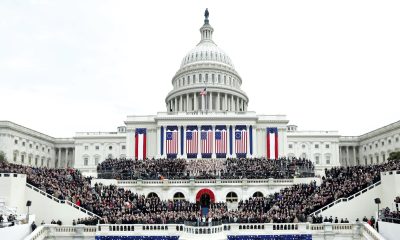Personal Finance
Housing, gas push inflation up higher than expected in September

The annual inflation rate leveled off at 3.7% in September, the same as the previous month, according to the Consumer Price Index (CPI) released by the Bureau of Labor Statistics (BLS).
However, on a monthly basis, inflation rose 0.4% in September after increasing by 0.6% the month before, slightly higher than the 0.3% pace that economists expected. Core inflation, which excludes more volatile food and energy prices, rose by a somewhat more muted 0.3% for the month, in line with expectations.
Housing costs were the most significant contributor to the overall price increase in September. Gas costs also impacted the gain in inflation and could continue to push prices higher as the conflict in the Middle East unfolds. This situation may send oil prices higher in the near term, which would likely impact near-term CPI forecasts, according to Jim Baird, Plante Moran Financial Advisors’ chief investment officer.
“Once the impact of recent energy price volatility is stripped out, inflation still appears to be gradually receding, but at a pace that could frustrate both consumers and policymakers,” Baird said. “A return to the [Federal Reserve’s] 2% target still appears to be further on the horizon than most would prefer, although a more pronounced slowdown in the economy could change that picture quickly.
“How the Fed will read this remains to be seen,” Baird continued. “Coming on the heels of last week’s surprisingly robust employment data, inflation data that remains above a comfortably sustainable pace could make the case for some Fed policymakers that more needs to be done to bring the economy back into balance.”
If you are struggling with high inflation, you could consider taking out a personal loan to pay down debt at a lower interest rate, reducing your monthly payments. You can visit Credible to find your personalized interest rate without affecting your credit score.
SOCIAL SECURITY CUTS: RETIREES COULD FACE MORE THAN $17,000 IN ANNUAL BENEFITS LOSSES
Trade groups want clearer picture of Fed’s rate path
The Fed has raised interest rates 11 times since March of last year, which has triggered a significant jump in mortgage rates, pushing them to their highest level in over two decades. How high rates move will largely depend on the central bank’s next decision.
The National Association of Home Builders, the Mortgage Bankers Association and the National Association of Realtors have asked the Fed to be more transparent about where rates are heading. In a joint letter sent to the central bank, the groups said that the uncertainty over the Fed’s rate path has contributed to recent interest rate hikes and volatility.
The organizations stated that the leading source of inflation in recent months has been increases in shelter costs. Indeed, September CPI showed shelter costs increased 7.2% annually and were responsible for over half of the gain for consumer prices.
“The most effective approach to tame shelter costs, and assist on the broader inflation fight, is to facilitate the construction of attainable, affordable housing,” the groups said. “Sustained wide spreads or further increases in interest rates make this economic goal more challenging by limiting lot development and home construction, exacerbating housing supply, and pricing out millions of households from the goal of homeownership.”
If you’re ready to shop around for a mortgage loan, you can use the Credible marketplace to help you quickly compare interest rates from multiple mortgage lenders and get prequalified in minutes.
EXTREME WEATHER IMPACTING HOW BUYERS SHOP FOR HOMES: ZILLOW
Recession risk back on the table
If September’s inflation figures push the Fed to stick to its restrictive interest rate policy and raise interest rates, it could reignite recession forecasts, according to the National Association of Federally-Insured Credit Unions (NAFCU) Economist Noah Yosif.
Mortgage giant Fannie Mae is still predicting a mild recession in the first half of 2024 as consumer spending continues to outpace incomes and the Federal Reserve’s previous interest rate increases work their way through the system.
“While the Federal Reserve might be inclined to maintain its terminal rate given indications of progress on core inflation, it will almost certainly view the ongoing resurgence within headline inflation as grounds for maintaining a restrictive policy posture over the coming year,” Yosif said in a statement. “Keeping rates higher for longer invariably diminishes the window of opportunity for a soft-landing, however; NAFCU believes a gradual cooldown in the labor market as well as consumption will provide the Federal Reserve adequate time to assess the trajectory of inflation and tailor monetary policy accordingly.”
If you’re worried about a potential recession, you can pay off high-interest debt now by taking out a personal loan with a lower interest rate, which could reduce your monthly payments. Visit Credible to speak with an expert and get your questions answered.
BIDEN’S STUDENT DEBT FORGIVENESS MAY BE TAXED IN THESE FIVE STATES
Have a finance-related question, but don’t know who to ask? Email The Credible Money Expert at moneyexpert@credible.com and your question might be answered by Credible in our Money Expert column.
Read the full article here

-

 Investing7 days ago
Investing7 days agoMoldova breakaway region to face new power cuts on Saturday, officials say By Reuters
-

 Investing7 days ago
Investing7 days agoReebok Co-Founder Backs Syntilay’s New AI, 3D-Printed Shoe
-

 Side Hustles7 days ago
Side Hustles7 days agoHow to Survive High-Demand Seasons Without Losing Customers
-

 Side Hustles5 days ago
Side Hustles5 days ago5 Things That Could Significantly Impact Your Company in 2025
-

 Investing5 days ago
Investing5 days agoNFI Group surge after board reshaped with new appointments, chairperson By Investing.com
-

 Side Hustles7 days ago
Side Hustles7 days agoShake It Up — Dunkin’ Debuts Star-Backed Winter Menu
-

 Side Hustles6 days ago
Side Hustles6 days agoHow Failing 22 Times Paved the Way to My Success
-

 Make Money7 days ago
Make Money7 days ago9 Easy Steps to Begin Your Gold Investment Journey


















